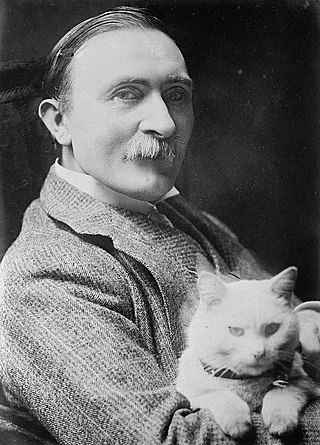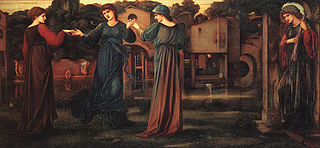Pygmalion or Pigmalion may refer to:

Sir Edward Coley Burne-Jones, 1st Baronet, was an English painter and designer associated with the Pre-Raphaelite Brotherhood's style and subject matter.

Henry Holiday was an English Victorian painter of historical genre and landscapes, also a stained-glass designer, illustrator, and sculptor. He was influenced by the Pre-Raphaelite Brotherhood, many of whom he knew.
Hope is an attitude which combines desire with expectation.

Nightwatching is a 2007 film about the artist Rembrandt and the creation of his 1642 painting The Night Watch. The film is directed by Peter Greenaway and stars Martin Freeman as Rembrandt, with Eva Birthistle as his wife Saskia van Uylenburg, Jodhi May as his lover Geertje Dircx, and Emily Holmes as his other lover Hendrickje Stoffels. Reinier van Brummelen is the director of photography. James Willcock, known for his esoteric sets, is the art director.

Sir Philip William Burne-Jones, 2nd Baronet was a Victorian Era British aristocrat, whose life and professional career as a painter spanned into the Edwardian. He was the first child of more famed British Pre-Raphaelite artist Sir Edward Burne-Jones and his wife Georgiana Macdonald, and a cousin of both author Rudyard Kipling and prime minister Stanley Baldwin. He produced more than 60 paintings, including portraits, landscapes, and poetic fantasies.
Edward, Ed, Ned, or Eddie Byrne may refer to:
Holy Family is a Christian term for Jesus, the Virgin Mary and St. Joseph.
Nativity or The Nativity may refer to:

The Last Sleep of Arthur in Avalon is a painting by Edward Burne-Jones, started in 1881. The massive painting measures 279 cm × 650 cm, and is widely considered to be Burne-Jones's magnum opus.
The nativity of Jesus is the biblical account of his birth.

King Cophetua and the Beggar Maid is an 1884 painting by the Pre-Raphaelite artist Edward Burne-Jones. The painting illustrates the story of 'The King and the Beggar-maid", which tells the legend of the prince Cophetua who fell in love at first sight with the beggar Penelophon. The tale was familiar to Burne-Jones through an Elizabethan ballad published in Bishop Thomas Percy's 1765 Reliques of Ancient English Poetry and the sixteen-line poem The Beggar Maid by Alfred, Lord Tennyson.
Burne is a surname. Notable people with the surname include:

The Flower Book by Edward Burne-Jones (1833–1898) is a series of 38 round watercolours, each about six inches across, painted from 1882 to 1898. The paintings do not depict flowers; rather, they were inspired by the flowers' names. Burne-Jones called them "a series of illustrations to the Names of Flowers". "Not a single flower itself appears", according to his wife Georgiana. They were painted for his private pleasure, many while he was resting at his summer home in Rottingdean, and were described by his wife as the "most soothing piece of work that he ever did". In 1905 Georgiana, by then a widow, published a limited edition of high-quality colour facsimiles.

The Golden Stairs is one of the best-known paintings by the Pre-Raphaelite artist Edward Burne-Jones. It was begun in 1876 and was exhibited at the Grosvenor Gallery in 1880.
Hope is a late oil painting by the Pre-Raphaelite artist Edward Burne-Jones. It was painted on commission for Mrs. George Marston Whitin of Whitinsville, Massachusetts in 1896.

Charles Fairfax Murray was a British painter, dealer, collector, benefactor, and art historian who was connected with the second wave of the Pre-Raphaelites.

The Mill is an Aesthetic Movement, Renaissance-inspired oil on canvas painting completed by Edward Burne-Jones in 1882. The painting's main feature is three women dancing in front of a mill pond on a summer evening, with a vague wooded landscape spanning the background. The Mill is an oil on canvas painting. It is 91 centimetres (36 in) in height, and 197 centimetres (78 in) in width.
This page is based on this
Wikipedia article Text is available under the
CC BY-SA 4.0 license; additional terms may apply.
Images, videos and audio are available under their respective licenses.









